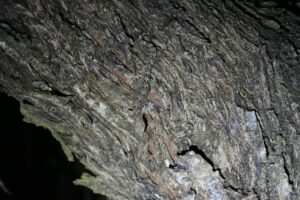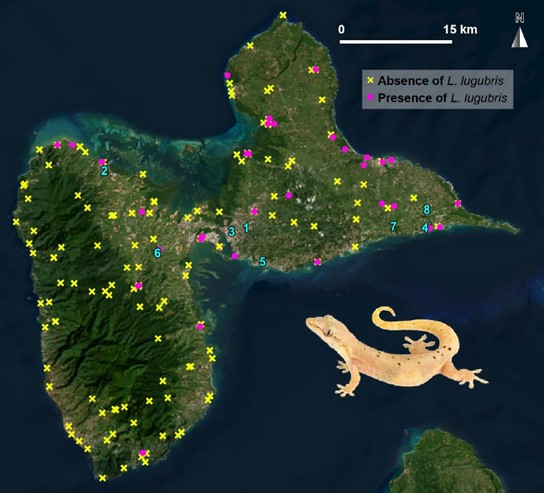In Guadeloupe, the Mourning Gecko was first detected in 2010. Thanks to its unique reproductive method and its ability to adapt to a wide variety of habitats, this reptile is able to rapidly expand into the territories it colonizes. A recently published study highlights the current status of this invasion.
Biological invasions represent a major threat to the biodiversity of island ecosystems, especially when these islands harbor unique biodiversity, as is the case with the Caribbean islands. In Guadeloupe, the Mourning Gecko (Lepidodactylus lugubris), originally from Southeast Asia and the Pacific Islands, was first observed in 2010. Its introduction could be linked to the pet trade or the clandestine arrival of one or more individuals as “stowaways” among goods transported by sea.
The Mourning Gecko: a species with high invasive potential
Already present on other Caribbean islands, this species benefits from several characteristics that may facilitate its expansion. Firstly, the animal is small, about 10 cm long, with a color ranging from beige to light brown, making it difficult to detect. Moreover, the Mourning Gecko reproduces through parthenogenesis: females can reproduce without males, laying unfertilized eggs that hatch into clones genetically identical to themselves. This unique trait ensures a high reproductive capacity and significant colonization potential. In fact, there are few, if any, males in the Mourning Gecko populations. Finally, the species is capable of exploiting a wide range of different habitats. The eggs of Mourning Geckos are also capable of resisting saltwater and drought.

The gecko is not always easy to spot!
However, the expansion of the Mourning Gecko could be slowed by interactions with other species, particularly with the Tropical House Gecko (Hemidactylus mabouia), another species introduced to Guadeloupe earlier. The latter, larger than the Mourning Gecko, could exert pressure through predation or competition for resources. The success of the Mourning Gecko’s invasion will therefore depend on the balance between these interactions and the species’ ability to colonize new environments.
To understand how the Mourning Gecko’s invasion has progressed since its introduction in Guadeloupe, a recent study conducted by a team of researchers from the Caribaea Initiative NGO as part of the MERCI project, funded by the Interreg Caribbean program, focused on the species’ spatial distribution and abundance in Guadeloupe.
A species colonizing all habitats
During the 2022 study, researchers surveyed a total of 160 sites across the entire archipelago, covering urban, suburban, and natural areas. Since the gecko is nocturnal, surveys were conducted between 5:30 PM and 1:00 AM. The species was observed in 36% of the sites visited on Grande-Terre, the island where the animal was introduced, and in 9% of the sites on Basse-Terre. In addition to a widespread presence, the results also show that the Mourning Gecko is not limited to areas inhabited by humans. The species is found not only in urban areas but also in natural habitats, confirming its ability to colonize a diverse range of environments.

A large part of Grande-Terre is affected by the Mourning Gecko invasion, while Basse-Terre remains less impacted so far.
High abundance and rapid expansion
To assess the relative abundance of the Mourning Gecko and its co-occurrence with the Tropical House Gecko, a second round of nocturnal surveys was conducted at a reduced number of sites, including 15 urban sites, 12 suburban sites, and seven natural sites. In these sites, all geckos were counted along a designated transect. The results indicate a greater abundance of the Mourning Gecko compared to the second species, which has been established in Guadeloupe for much longer. Moreover, contrary to expectations, the Mourning Gecko shows higher abundance in natural environments compared to urban areas.
In the final phase of the study, researchers returned to a hotel complex in Grande-Terre, where a previous study had been conducted by other researchers in 2018, and they meticulously replicated the same protocol used at that time. The results indicate that in just four years, the Mourning Gecko population has doubled at this site, once again confirming the rapid expansion of the species.

Gloria Chance, a master’s student, surveys a site in search of geckos.
Further studies and management measures needed
This new study confirms the rapid and concerning expansion of the Mourning Gecko in Guadeloupe, with a significant increase in population and the exploitation of various habitats. If no management measures are taken quickly, it is likely that this invasion dynamic will continue in Guadeloupe and spread to other territories. Indeed, the species has recently been observed in Martinique, and a similar dynamic is expected unless control measures are implemented.
As with any invasive species, impacts on local biodiversity are expected, although these impacts remain unknown for now. Further studies are needed to better understand the species’ ecology, particularly its interactions with native species and its diet.
Reference
Chance, G., Louppe, V., Cézilly, F. & Cambrone, C. (2024). Rapid expansion of the invasive mourning gecko, Lepidodactylus lugubris (Duméril & Bibron, 1836), in Guadeloupe, French Antilles. BioInvasions Records 13: 1055-1066.
This study was conducted as part of the MERCI project, co-funded by the INTERREG Caribbean program under the European Regional Development Fund.



